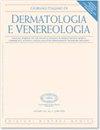天疱疮免疫血清学诊断。
IF 2
Q3 Medicine
Giornale Italiano Di Dermatologia E Venereologia
Pub Date : 2020-11-23
DOI:10.23736/S0392-0488.20.06788-7
引用次数: 3
摘要
天疱疮是一种罕见的自身免疫性起泡疾病,表现为皮肤和粘膜的疼痛糜烂和水泡。这种疾病是由自身抗体攻击桥粒体蛋白引起的,桥粒体蛋白是细胞-细胞接触稳定性和表皮完整性所必需的。desmoglin (Dsg) 1和Dsg3是天疱疮的两种主要靶抗原。然而,多年来已经描述的许多其他靶蛋白似乎与表皮完整性的丧失有关。临床检查,结合血清学进展和靶向抗原的检测,可以区分几种天疱疮亚型,其中寻常型天疱疮和叶状天疱疮最常见。目前,天疱疮的血清学分析是诊断算法的基本步骤。这是基于对临床症状的分析、病变皮肤的组织病理学检查、通过直接和间接免疫荧光检测组织结合抗体和循环抗体,以及通过酶联免疫吸附试验(ELISA)或western blot分析确定目标抗原。正确和详尽的诊断算法是表征天疱疮亚型的基础,最后允许采用正确的治疗方法。此外,患者血清中循环抗体的质量和数量提供了临床病程、疾病严重程度和治疗反应的重要信息,从而相关地影响医生的决策。为了促进这一过程,具有高灵敏度和特异性的“易于执行”的诊断试剂盒正在商业化。在这篇综述中,我们着重于现有的方法和建立的检测方法来正确检测天疱疮循环自身抗体。此外,我们讨论了五种最相关亚型(寻常型天疱疮、叶状天疱疮、素食性天疱疮、副肿瘤性天疱疮和细胞间IgA皮肤病(也称为IgA天疱疮))的亚型特异性血清学特征。本文章由计算机程序翻译,如有差异,请以英文原文为准。
Immune serological diagnosis of pemphigus.
Pemphigus is a rare autoimmune blistering disease which manifests with painful erosions and blisters of the skin and mucosa. This disorder is caused by autoantibodies attacking desmosomal proteins, necessary for cell-cell contact stability and epidermal integrity. Desmoglein (Dsg) 1 and Dsg3 are the two major target antigens in pemphigus. Yet, many other target proteins, which have been described over the years, seem to be involved in the loss of epidermal integrity. Clinical examination, combined to serological advances and detection of targeted antigens, permitted to differentiate among several pemphigus subtypes, in which pemphigus vulgaris and pemphigus foliaceus are the most common. Nowadays, serological analysis in pemphigus is a fundamental step of the diagnostic algorithm. This is based on analysis of clinical symptoms, histopathological examination of lesional skin, detection of tissue bound and circulating antibodies by direct and indirect immunofluorescence and determination of target antigens either by enzyme-linked immunosorbent essay (ELISA) or by western blot analysis. A correct and exhaustive diagnostic algorithm is fundamental to characterize pemphigus subtypes, which lastly permits to adopt a correct treatment approach. Moreover, quality and quantity of circulating antibodies in patient's sera deliver important information regarding clinical course, disease severity and treatment response, thus relevantly affecting physician's decision. To facilitate this process, "easy-to-perform" diagnostic kits with high sensitivity and specificity are being commercialized. In this review, we focus on available methods and established assays to correctly detect circulating autoantibodies in pemphigus. Further, we discuss subtype specific serological peculiarities in the five most relevant subtypes (pemphigus vulgaris, pemphigus foliaceus, pemphigus vegetans, paraneoplastic pemphigus and intercellular IgA dermatosis (also called as IgA pemphigus).
求助全文
通过发布文献求助,成功后即可免费获取论文全文。
去求助
来源期刊

Giornale Italiano Di Dermatologia E Venereologia
DERMATOLOGY-
CiteScore
1.90
自引率
0.00%
发文量
0
审稿时长
6-12 weeks
期刊介绍:
The journal Giornale Italiano di Dermatologia e Venereologia publishes scientific papers on dermatology and sexually transmitted diseases. Manuscripts may be submitted in the form of editorials, original articles, review articles, case reports, therapeutical notes, special articles and letters to the Editor.
Manuscripts are expected to comply with the instructions to authors which conform to the Uniform Requirements for Manuscripts Submitted to Biomedical Editors by the International Committee of Medical Journal Editors (www.icmje.org). Articles not conforming to international standards will not be considered for acceptance.
 求助内容:
求助内容: 应助结果提醒方式:
应助结果提醒方式:


